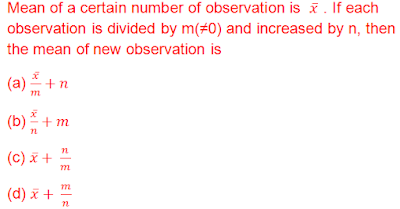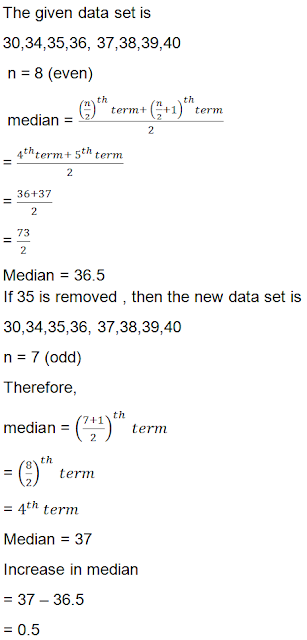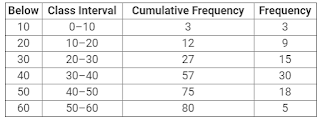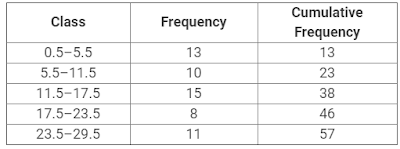Chapter 7 Statistics R.D. Sharma Solutions for Class 10th Math MCQ's
Multiple Choice Questions1. Which of the following is not a measure of central tendency ?
(a) Median
(b) Median
(c) Mode
(d) Standard deviation
Hence , the correct option is c
2. The algebraic sum of the deviations of a frequency distribution from its mean is
(a) Always positive
(b) Always Negative
(c) 0
(d) A non – zero number
Solution
The algebraic sum of the deviation of a frequency distribution from its mean is zero .
Hence , the correct option is c.
(a) n+1/2
(b) n-1/2
(c) n/2
(d) n/2 + 1
= 1+2+3+…+n/n
= n(n+1)/2/n
= n+1/2
Hence , the correct option is a .
(a) Mode = 3 Mean – 2 Median
(b) Mode = 2 median – 3 Mean
(c) Mode = 3 Median – 2 Mean
(d) Mode = 3 Median + 2 Mean
Solution
The relation between mean, median and mode is
Mode = 3 Median – 2 Mean
Mode = 3 Median – 2 Mean
Hence, the correct option is c .
5. Which of the following cannot be determined graphically ?
(a) Mean
(b) Median
(c) Mode
(d) None of these
Solution
‘Mean’ cannot be determined by graphically.
Hence, the correct option is a .
6. The median of a given frequency distribution is found graphically with the help of
(b) Frequency curve
(c) Frequency Polygon
(d) Ogive
Solution
The median of a given frequency distribution is found graphically with the help of ‘ogive’ .
Hence , the correct option is d .
7. The mode of a frequency distribution can be determined graphically from
(a) Histogram
(b) Frequency polygon
(c) Ogive
(d) Frequency curve
Solution
The mode of a frequency distribution can be determined from ‘’Histogram’’ .
Hence, the correct option is a.
(a) Histogram
(b) Frequency polygon
(c) Ogive
(d) Frequency curve
Solution
The mode of a frequency distribution can be determined from ‘’Histogram’’ .
Hence, the correct option is a.
8. Mode is
(a) Least frequency value
(b) Middle most value
(c) Most frequent value
(d) None of these
Solution
Mode is ‘’ Most frequent value’’ .
Hence , the correct option is c .
9. The mean of n observation is x̅ . If the first item is increased by 1, second by 2 and so on, then the new mean is
(a) x̅ + n(b) x̅ + n/2
(c) x̅ + n+1/2
(d) None of these
Solution
Let x1 , x2 , x3, …..,xn be the n observations .
Mean = x̅ = x1+x2+…+xn/n
⇒ x1 + x2 +x3 + …+ xn = n x̅
If the first item is increased by 1, second by 2 and so on .
Then, the new observations are x1 + x2 + 2 , x3 + 3, …, xn + n.
New mean = (x1 + 1) + (x2+2) + (x3 + 3) + … +(xn+n)/n
= x1+ x2 + x3 + … + xn + (1+2+3+…+n)
= n x̅ + (n(n+1)/2)/n
= x̅ + n+1/2
Hence , the correct answer is c .
(a) Mode = 2 median – 3 mean
(b) Mode = 2 median + 3 mean
(c) Mode = 3 median – 2 mean
(d) Mode = 3 median + 2 mean
Solution
We have ,
Mode = 3 median – 2 mean
Hence , the correct option is c .
Variable (x) : 1 2 3 4 5
Frequency 4 5 y 1 2
Solution

Mean = Σfx/ Σf
2.6/1 = 28 + 3y/12 + y
31.2 + 2.6y = 28 + 3y
0.4y = 3.2
y = 3.2/0.4
y = 8
Hence, the correct option is b .
(a) Mode = 2 median – 3 mean
(b) Mode = median – 2 mean
(c) Mode = 2 median – mean
(d) Mode = 3 median – 2 mean
Solution
Mode = 3 median - 2 mean
Hence, the correct option is d .
Solution
x̅ = Σfixi/Σfi
Hence, the correct option is a .
(a) 1
(b) 2
(c) 6
(d) 4
Solution
The given observations are x, x+3, x+6, x+9, and x +12.
∴ Σ x = 5x + 30, n = 5, x̅ = 10
Now,
x̅ = Σx/n
10 = 5x + 30/5
50 = 5x + 30
5x = 20
x = 4
Hence, the correct option is d.
(a) 27
(b) 25
(c) 28
(d) 30
Solution
The given observations are 24, 25, 26, x + 2, x + 3, 30, 31, 34
Median = 27.5
Here, n = 8
Median = (n/2)th term + (n/2 + 1)th term / 2
27.5 = 4th term + 5 th term/2
27.5 = (x+2) + (x+3) / 2
27.5 = 2x + 5 / 2
2x + 5 = 55
2x = 50
x = 25
Hence , the correct option is b .
16. If the median of the data : 6,7,x-2, x,17,20 written ascending order is, 16 . Then x =
(a) 15
(b) 16
(c) 17
(d) 18
Solution
The given observations arranged in ascending order are
6,7,x-2,x,17,20
n = 6(even), median = 16
Median = (n/2)th term + (n/2 +1)th term/2
= 3rd term + 4th term/2
= x – 2 + x /2
= 2x – 2 / 2
= 16 = 2x – 2 / 2
= 2x – 2 = 32
x = 17
Hence the correct option is c.
17. The median of first 10 prime numbers is
(a) 11
(b) 12
(c) 13
(d) 14
Solution
First 10 prime numbers are 2 ,3 , 5 ,7 , 11 , 13 , 17, 19 , 23, 29 .
n = 10 (even)
Median = (n/2)th term + (n/2+1)th term
= 5th term + 6th term / 2
= 11 + 13 / 2
= 24/2
= 12
Hence, the correct option is b.
18. If the mode of the data : 64,60,48, x, 43, 34 is 43, then x + 3
(a) 44(b) 45
(c) 46
(d) 48
Solution
Now, this is possible only when x = 43. In this case, the frequency of the observation 43 would be 3.
Hence,
x + 3 = 46
Hence, the correct option is c .
19. If the mode of the data : 16, 15, 17, 16, 15, x, 19, 17, 14 is 15, then x =
(a) 15
(b) 16
(c) 17
(d) 19
Solution
This is possible only when x = 15. In this case, the frequency of 15 would be 3.
Hence , the correct answer is a .
20. The mean of 1,3,4,5,7,4 is m. The numbers 3,2,2,4,3,3,p have mean m – 1 and median q. Then, p+q =
(a) 4
(b) 5
(c) 6
(d) 7
Solution
(b) 5
(c) 6
(d) 7
Solution
1,3,4,5,7,4
Mean = 1+3+4+5+7+4/6
= 24/6
= 4
Consider the numbers 3,2,2,4,3,3,p.
Mean = 3+2+2+4+3+3+p / 7.
⇒ 7× (4 – 1) = 17 + p
⇒ 21 = 17 + p
⇒ p = 4
Arranging the numbers 3,2,2,4,3,3,4 in ascending order, we have
2,2,3,3,3,4,4
Median = (n+1/2)th term
q = (7+1/2)th term
= (8/2)th term
= 4th term
q = 3
so,
p+q = 4 + 3
= 7
Hence , the correct option is d.
21. If the mean of frequency distribution is 8.1 and Σfixi = 132 + 5k, Σfi = 20, then k =
Mean = 1+3+4+5+7+4/6
= 24/6
= 4
Consider the numbers 3,2,2,4,3,3,p.
Mean = 3+2+2+4+3+3+p / 7.
⇒ 7× (4 – 1) = 17 + p
⇒ 21 = 17 + p
⇒ p = 4
Arranging the numbers 3,2,2,4,3,3,4 in ascending order, we have
2,2,3,3,3,4,4
Median = (n+1/2)th term
q = (7+1/2)th term
= (8/2)th term
= 4th term
q = 3
so,
p+q = 4 + 3
= 7
Hence , the correct option is d.
21. If the mean of frequency distribution is 8.1 and Σfixi = 132 + 5k, Σfi = 20, then k =
(a) 3
(b) 4
(c) 5
(d) 6
Solution
Given:
Σfixi = 132 + 5k, Σfi = 20 and mean = 8.1
Then,
Mean = Σfixi / Σfi
8.1 = 132 + 5k / 20
162 = 132 + 5k
5k = 30
k = 6
Hence , the correct option is d .
22. If the mean of 6,7,x,8,y,14 is 9, then
(a) x+y = 21
(b) x+y = 19
(c) x-y = 19
(d) x-y = 21
Solution
The given observation are 6,7,x,8,y,14.
Mean = 9 (Given)
⇒ 6+7+x+8+y+14 / 6 = 9
⇒ 35 + x + y = 54
⇒ x + y = 54 – 35 = 19
Hence , the correct option is b .
(c) 5
(d) 6
Solution
Given:
Σfixi = 132 + 5k, Σfi = 20 and mean = 8.1
Then,
Mean = Σfixi / Σfi
8.1 = 132 + 5k / 20
162 = 132 + 5k
5k = 30
k = 6
Hence , the correct option is d .
22. If the mean of 6,7,x,8,y,14 is 9, then
(a) x+y = 21
(b) x+y = 19
(c) x-y = 19
(d) x-y = 21
Solution
The given observation are 6,7,x,8,y,14.
Mean = 9 (Given)
⇒ 6+7+x+8+y+14 / 6 = 9
⇒ 35 + x + y = 54
⇒ x + y = 54 – 35 = 19
Hence , the correct option is b .
23.

Solution

24. If the mean of first n natural numbers is 5n/9 then n =
(a) 5
(b) 4
(c) 9
(d) 10
Solution

25. The arithmetic mean and mode of a data are 24 and 12 respectively , then its median is
(a) 25
(b) 18
(c) 20
(d) 22
Solution
Given :
Mean = 24 and Mode = 12
We know that
Mode = 3 Median – 2 Mean
⇒ 12 = 3 median – 2 × 24
⇒ 3 median = 12 + 48 = 60
⇒ Median = 20
26. The mean of first n odd natural number is
(a) n+1/2
(b) n/2
(c) n
(d) n2
Solution

27. The mean of first n odd natural numbers is n2/81, then n =
(a) 9
(b) 81
(c) 27
(d) 18
Solution

28. If the difference of mode and median of a data is 24, then the difference of median and mean is
(a) 12
(b) 24
(c) 8
(d) 36
Solution
Given :
Mode – Median = 24
We know that
Mode = 3 median – 2 mean
Now,
Mode – median = 2(Median – Mean)
⇒ 24 = 2(Median – Mean)
⇒ Median – Mean = 12
29. If the arithmetic mean , 7,8,x,11,14 is x, then x =
(a) 9
(b) 9.5
(c) 10
(d) 10.5
Solution
The given observations are 7,8,x,11,14 .
Mean = x (Given)
Now,
Mean = 7+8+x+11+14 / 5
⇒ x = 40+x / 5
⇒ 5x = 40 + x
⇒ 4x = 40
⇒ x = 10
30. If the mode of a series exceeds its mean by 12, then mode exceeds the median by
(a) 4
(b) 8
(c) 6
(d) 10
Solution
Given: Mode – Mean = 12
We know that
Mode = 3 median – 2 Mean
∴ Mode – Mean = 3(Median – Mean)
⇒ 12 = 3(Median – Mean)
⇒ Median – Mean = 4 …(1)
Again ,
Mode = 3 Median – 2 Mean
⇒ 2 Mode = 6 Median – 4 Mean
⇒ Mode – Mean + Mode = 6 Median – 5 Mean
⇒ 12 + (Mode – Median) = 5(Median – Mean)
⇒ 12 + (Mode – Median) = 20 [Using (1)]
⇒ Mode – Median = 20 – 12 = 8
(a) 15
(b) 30
(c) 14
(d) 29
Solution

32.




34.
(a) 23
(b) 24(c) 27
(d) 25
Solution

(a) 2
(b) 1.5
(c) 1
(d) 0.5

(a) Evenly distributed over all the classes.
(b) Centred at the class marks of the classes.
(c) Centred at the upper limit of the classes .
(d) Centred at the lower limit of the classes .
Solution
We know that while computing the mean of a grouped data, the frequencies are centered at the class marks of the classes .
37.

Solution

38. For the following distributions :
Class : 0-5 5-10 10-15 15-20 20-25
Frequency : 10 15 12 20 9
The sum of the lower limits of the median and modal class is
(a) 15
(b) 25
(c) 30
(d) 35
Solution

The highest frequency is 20, which lies in the interval 15-20.
Therefore, the lower limit of modal class is 15.
So, the required sum is 10 +15 = 25 .

Here, N = 66.
∴ N/2 = 33, which lies in the interval 10-15.
So, the lower limit of the median class is 10.The highest frequency is 20, which lies in the interval 15-20.
Therefore, the lower limit of modal class is 15.
So, the required sum is 10 +15 = 25 .
Below: 10 20 30 40 50 60
Number of students : 3 12 27 57 75 80
the modal class is
(a) 10-20
(b) 20-30
(c) 30-40
(d) 50-60
Solution

Here, N = 80
∴ N/2 = 40, which lies in the interval 30-40.Therefore, the modal class is 30-40.
40. Consider the following frequency distribution :
Class: 65-85 85-105 105-125 125-145 145-165 165-185 185-205Frequency : 4 5 13 20 14 7 4
The difference of the upper limit of the median class and the lower limit of the modal class is :

∴ N/2 = 33.5, which lies in the interval 125-145.
Therefore, the lower limit of the median class is 125.
The highest frequency is 20, which lies in the interval 125-145.
Therefore, the upper limit of modal class is 145.
So, the required difference is 145-125 = 20.
41.

Solution

Solution
The given formula represents the formula to find the mean by assumed mean method .
Here, di = xi – a where xi is the ith observation and a is assumed mean .So, di’s are the deviation from a of mid – points of the classes .
42. The abscissa of the point of intersection of less than type and of the more than type cumulative frequency curves of a grouped data gives its
(a) Mean
(b) Median
(c) Mode
(d) All the three above
Solution
The less than ogive and more than ogive when drawn on the same graph intersect at a point . From this point, if we draw a perpendicular on the x-axis, the point at which it cuts the x-axis gives us the median.
Thus, the abscissa of the point if intersection of less than type and of the more than type cumulative curves of a grouped data gives its median.
43. Consider the following frequency distribution :
Class: 0-5 6-11 12-17 18-23 24-29
Frequency: 13 10 15 8 11
The upper limit of the median class is
(a) 17
(b) 17.5
(c) 18
(d) 18.5
Solution
Class: 0-5 6-11 12-17 18-23 24-29
Frequency: 13 10 15 8 11
The upper limit of the median class is
(a) 17
(b) 17.5
(c) 18
(d) 18.5
Solution
The given classes in the table are non-continuous. So , we first make the classes continuous by adding 0.5 to the upper limit and substracting 0.5 from the lower limit in each class .
 Now, from the table we see that N = 57.
Now, from the table we see that N = 57.

So, N/2 = 57/2 = 28.5
28.5 lies in the class 11.5 – 17.5
The upper limit of the interval 11.5-17.5 is 17.5

